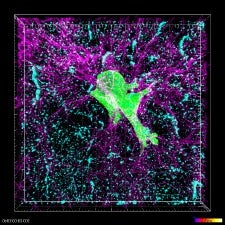Biological Physics

Biological physicists use principles of physics to understand biological processes. The spatial scale of these processes spans the single molecule to the biological network. On the single molecule level, physicists make significant contributions in the development of experimental methods that illuminate molecular conformations, measure interactions with other molecules and monitor the formation of scaffolding that forms the cellular supporting environment. On the network level, collective behaviors and systems far from equilibrium prevail, requiring tools from non-linear dynamics and statistical mechanics to quantify these interactions. Fabrication of integrated micro-devices applied to human health also falls under the purview of the biological physicist. These sophisticated tools utilizing state-of-the art technologies improve quality of life and health care as they speed drug delivery and facilitate the diagnosis of disease.
At Georgetown, biological physicists use advanced optical imaging techniques such as high-speed confocal microscopy and optical tweezers to study a variety of systems including properties of cell motility, neurite migration in 3D bio-matrices and biopolymer rheology. Arrays of extracellular microelectrodes are used to study pattern formation in in vitro neural networks. The Georgetown Nanoscience and Microtechnology Lab (GNuLab) is home to a wide range of state-of-the-art fabrication and characterization instruments to develop bio-technologies for the healthcare industry.
Daniel Blair — soft glasses, colloidal and polymer physics, crumpling, biopolymer rheology, confocal microscopy of soft materials, granular dynamics and statics
John Currie — materials science of thin solid films, industrial and applied physics, surface and interface chemical physics, semiconductor electrical and electro-optical devices and technology, renewable energy generation and storage, polymer physics, electrochemistry, environment monitoring technologies
Rhonda Dzakpasu — spatio-temporal pattern formation in in vitro neural systems, extracellular multi-electrode array recordings, computational modeling of coherent activity in neural networks, development of non-linear methods of data analysis
David Egolf — statistical physics of nonequilibrium dynamical systems, including fluids, granular media, cardiac and neural tissue, and biopolymer networks; effective theories of QCD.
Peter Olmsted – soft matter physics and biophysics: non-equilibrium physics, phase transitions, and (nano)mechanics; theory and computer simulations; shear banding and microfluidics, polymers, elastomers, surfactants, colloids, liquid crystals; protein, motor, and lipid bilayer membrane dynamics and mechanics.
Makarand Paranjape — micro-/nano-technologies for sensors, actuators, and structural systems, silicon/polymer and carbon nanotube device fabrication, biomedical engineering
Jeff Urbach — cellular biophysics, physics of soft matter, biomaterials, biomedical optics, granular dynamics, fluid dynamics, nonlinear dynamics
